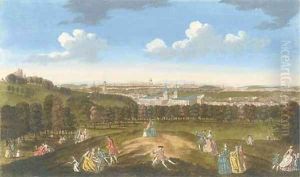Peter Tillemans And John Bowles Paintings
Peter Tillemans was a Flemish painter born in Antwerp in 1684. He is chiefly remembered for his contributions to British art, particularly in the fields of landscape and sporting paintings. Tillemans moved to England around 1708, during a period when the demand for paintings was on the rise, thanks in part to the Act of Union between England and Scotland in 1707, which fostered a sense of national stability and prosperity. His arrival in England coincided with the growing popularity of horse racing and other sports, which became frequent subjects of his works. He is often credited with being one of the pioneers of British sporting painting, a genre that would flourish throughout the 18th century.
Tillemans was also known for his landscapes and historical scenes. His work reflects a keen observation of nature and an ability to capture the English countryside with a fresh perspective, likely influenced by his Flemish training. He worked on several large-scale projects, including panoramic views and battle scenes, and he was frequently employed by the aristocracy to depict their estates and gardens, which were becoming increasingly fashionable. His paintings of Newmarket races are particularly celebrated for their dynamic composition and detail.
Peter Tillemans' influence extended beyond his own artworks. He taught and influenced a number of British artists, helping to lay the groundwork for the development of British landscape and sporting art. Despite his Flemish origins, his contribution to British art was significant, and he is often considered a key figure in its early 18th-century history. Tillemans died in 1734, leaving behind a legacy that would inspire future generations of artists.
John Bowles, on the other hand, was not an artist but rather a prominent British print and map seller of the 18th century. While he shares temporal proximity with Peter Tillemans, Bowles' contribution to the art world was in a different capacity. Operating from his establishment in London, Bowles published and distributed prints, maps, and atlases, becoming a significant figure in the dissemination of visual culture during his time. The mention of John Bowles alongside Peter Tillemans may arise from Bowles' role in publishing prints after Tillemans' works, thus helping to popularize the artist's images and contributing to his posthumous reputation. However, detailed biographical information specific to Bowles' life, such as his birth and death dates, is less well-documented in the context of this query, focusing instead on his professional achievements and impact on the circulation of art and information in 18th-century Britain.
